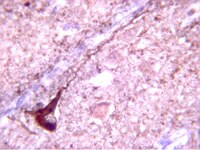AB9668 Sigma-AldrichAnti-Tau phospho Threonine 231 Antibody
Anti-Tau phospho Threonine 231 Antibody detects level of Tau phospho Threonine 231 & has been published & validated for use in WB.
More>> Anti-Tau phospho Threonine 231 Antibody detects level of Tau phospho Threonine 231 & has been published & validated for use in WB. Less<<Prodotti consigliati
Panoramica
| Replacement Information |
|---|
Tabella delle specifiche principali
| Species Reactivity | Key Applications | Host | Format | Antibody Type |
|---|---|---|---|---|
| H | WB | Rb | Affinity Purified | Polyclonal Antibody |
| References |
|---|
| Product Information | |
|---|---|
| Format | Affinity Purified |
| Presentation | Affinity purified immunoglobulin. Liquid in Dulbecco's PBS (without Mg2+ and Ca2+), pH 7.3, 50% glycerol with 1.0 mg/mL BSA and 0.05% sodium azide. |
| Quality Level | MQ100 |
| Physicochemical Information |
|---|
| Dimensions |
|---|
| Materials Information |
|---|
| Toxicological Information |
|---|
| Safety Information according to GHS |
|---|
| Safety Information |
|---|
| Packaging Information | |
|---|---|
| Material Size | 100 µL |
| Transport Information |
|---|
| Supplemental Information |
|---|
| Specifications |
|---|
| Global Trade Item Number | |
|---|---|
| Numero di catalogo | GTIN |
| AB9668 | 04053252337000 |
Documentation
Anti-Tau phospho Threonine 231 Antibody MSDS
| Titolo |
|---|
Anti-Tau phospho Threonine 231 Antibody Certificati d'Analisi
| Titolo | Numero di lotto |
|---|---|
| Anti-Tau phospho Threonine 23 - 2117253 | 2117253 |
| Anti-Tau phospho Threonine 231 - 2123661 | 2123661 |
| Anti-Tau phospho Threonine 231 - 2143477 | 2143477 |
| Anti-Tau phospho Threonine 231 - 1992655 | 1992655 |
| Anti-Tau phospho Threonine 231 - 2002183 | 2002183 |
| Anti-Tau phospho Threonine 231 - 2058951 | 2058951 |
| Anti-Tau phospho Threonine 231 - 2062319 | 2062319 |
| Anti-Tau phospho Threonine 231 - 2266738 | 2266738 |
| Anti-Tau phospho Threonine 231 - 2501477 | 2501477 |
| Anti-Tau phospho Threonine 231 - 3231925 | 3231925 |
Riferimenti bibliografici
| Panoramica dei riferimenti bibliografici | Codice d'identificazione nel Pub Med |
|---|---|
| Pericyte loss influences Alzheimer-like neurodegeneration in mice. Sagare, AP; Bell, RD; Zhao, Z; Ma, Q; Winkler, EA; Ramanathan, A; Zlokovic, BV Nature communications 4 2932 2013 Mostra il sommario | 24336108
 |
| Increased Tau Phosphorylation and Impaired Brain Insulin/IGF Signaling in Mice Fed a High Fat/High Cholesterol Diet. Bhat, Narayan R and Thirumangalakudi, Lakshmi J. Alzheimers Dis., (2013) 2013 Mostra il sommario | 23703152
 |
| Dephosphorylation of Tau by protein phosphatase 5: impairment in Alzheimer's disease. Liu, F., et al. J. Biol. Chem., 280(3):1790-1796 (2005) 2004 | 15546861
 |
| The retinoic acid and brain-derived neurotrophic factor differentiated SH-SY5Y cell line as a model for Alzheimer's disease-like tau phosphorylation. Jämsä, A., et al. Biochem. Biophys. Res. Comm., 319:993-1000 (2004) 2004 | 15184080
 |
| O-GlcNAcylation regulates phosphorylation of tau: a mechanism involved in Alzheimer's disease. Liu, Fei, et al. Proc. Natl. Acad. Sci. U.S.A., 101: 10804-9 (2004) 2004 Mostra il sommario | 15249677
 |
| Specific tau phosphorylation sites correlate with severity of neuronal cytopathology in Alzheimer's disease. Augustinack, J.C., et al. Acta Neuropathol., 103:26-35 (2002) 2002 | 11837744
 |
| Site-specific phosphorylation of tau accompanied by activation of mitogen-activated protein kinase (MAPK) in brains of Niemann-Pick type C mice. Sawamura, N, et al. J. Biol. Chem., 276: 10314-9 (2001) 2001 Mostra il sommario | 11152466
 |
| Expression of human apolipoprotein E4 in neurons causes hyperphosphorylation of protein tau in the brains of transgenic mice. Tesseur,I., et al. Am. J. Pathol., 156(3):951-964 (2000) 1999 | 10702411
 |
| Phosphorylation of microtubule-associated protein tau is regulated by protein phosphatase 2A in mammalian brain. Implications for neurofibrillary degeneration in Alzheimer's disease. Gong, C.X., et al. J. Biol. Chem., 275(8):5535-5544 (2000) 1999 | 10681533
 |
| Tau is phosphorylated by GSK-3 at several sites found in Alzheimer disease and its biological activity markedly inhibited only after it is prephosphorylated by A-kinase. Wang, J.Z., et al. FEBS Lett., 436(1):28-34 (1998) 1998 | 9771888
 |
Newsletters / Publications
| Title |
|---|
| Research Focus - Volume 2, 2013 |












